Megalochori
the Neoclassical mansions and the typical cave houses of Santorini
the Neoclassical mansions and the typical cave houses of Santorini
This beautiful village is located 9.5 km away from Fira, SW of Pyrgos. It follows the type of excavated settlements and was developed along the bottom of a valley sprawling over its “branches”.
As Dr Dora Monioudi-Gavala * points out, references to Megalohori are found in written sources in the mid- 17th century. It is present in Olivier’s depiction of Santorini in 1801.
Both entrances lead from the main road to the center of the village with the main square of “Potamos” where the churches of the Presentation of Virgin Mary and Aghioi (St.) Anargiroi dominate. It is also worth noticing the elaborate steeples of Zoodochos Pigi and of other churches.
The soil in the area has always been fertile; so, there were many vineyards, and its residents had made money of winemaking. There are still some kánaves (old wineries) left from the time when wine production was quite significant, with exports to Russia.
Residents love virgin beaches located near Megalohori on the south side of the island called Kamara, Vigles, Almyra, Katavati, Chana. After swimming they used to feast and revel with violins and lutes till late at night under the “trafs” (very tall walls created by water and wind reminiscent of lunar landscape). The excursion is still organized in the traditional way, with donkeys leading visitors to these isolated beaches. In Aghios (St.) Efstathios, at the start of the road leading to Thermi beach with the thermal springs, you will enjoy a great sunset.

This beautiful village is located 9.5 km away from Fira, SW of Pyrgos. It follows the type of excavated settlements and was developed along the bottom of a valley sprawling over its “branches”.
As Dr Dora Monioudi-Gavala * points out, references to Megalohori are found in written sources in the mid- 17th century. It is present in Olivier’s depiction of Santorini in 1801.
Both entrances lead from the main road to the center of the village with the main square of “Potamos” where the churches of the Presentation of Virgin Mary and Aghioi (St.) Anargiroi dominate. It is also worth noticing the elaborate steeples of Zoodochos Pigi and of other churches.
The soil in the area has always been fertile; so, there were many vineyards, and its residents had made money of winemaking. There are still some kánaves (old wineries) left from the time when wine production was quite significant, with exports to Russia.
Residents love virgin beaches located near Megalohori on the south side of the island called Kamara, Vigles, Almyra, Katavati, Chana. After swimming they used to feast and revel with violins and lutes till late at night under the “trafs” (very tall walls created by water and wind reminiscent of lunar landscape). The excursion is still organized in the traditional way, with donkeys leading visitors to these isolated beaches. In Aghios (St.) Efstathios, at the start of the road leading to Thermi beach with the thermal springs, you will enjoy a great sunset.

* Extract from the book “Santorini: Society and Shelter, 15th-20th century”, by Dr Dora Monioudi-Gavala/A publication of Lukas and Evangelos Bellonias Foundation.
